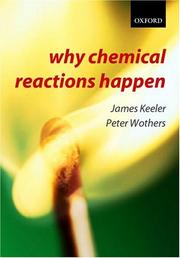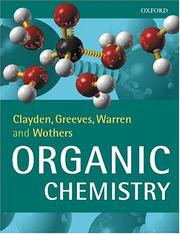| Listing 1 - 5 of 5 |
Sort by
|
Book
ISBN: 9780199289301 0199289301 Year: 2008 Publisher: Oxford Oxford University Press
Abstract | Keywords | Export | Availability | Bookmark
 Loading...
Loading...Choose an application
- Reference Manager
- EndNote
- RefWorks (Direct export to RefWorks)
'Chemical Structure and Reactivity' depicts the subject as a seamless discipline, showing how inorganic, organic and physical concepts can be blended together to achieve the common goal of understanding chemical systems. The book includes in-text examples and extensive end-of-chapter questions to encourage learning.
Chemical structure --- Reactivity (Chemistry) --- Chemical structure. --- Reactivity (Chemistry). --- Chemical reaction, Conditions and laws of --- Chemical reactions --- Structure, Chemical --- Chemistry, Physical and theoretical --- Matter --- Constitution

ISBN: 0199249733 9780199249732 Year: 2009 Publisher: Oxford ; New York : Oxford University Press,
Abstract | Keywords | Export | Availability | Bookmark
 Loading...
Loading...Choose an application
- Reference Manager
- EndNote
- RefWorks (Direct export to RefWorks)
Chemical reactions --- Reactions, Chemical --- Chemical processes --- Chemical reactions. --- Réactions chimiques --- Réactions chimiques --- Réactions chimiques.
Book
ISBN: 9780199604135 Year: 2014 Publisher: Oxford Oxford University Press
Abstract | Keywords | Export | Availability | Bookmark
 Loading...
Loading...Choose an application
- Reference Manager
- EndNote
- RefWorks (Direct export to RefWorks)

ISBN: 0198503466 9780198503460 0198503474 9780198503477 Year: 2001 Publisher: Oxford : Oxford University Press,
Abstract | Keywords | Export | Availability | Bookmark
 Loading...
Loading...Choose an application
- Reference Manager
- EndNote
- RefWorks (Direct export to RefWorks)
A new style of textbook, aimed principally at the European (and British in particular) student. It is needed because almost all current organic chemistry texts are written to a fixed American pattern. This text is different from these in a number of important ways: The approach is based on explanation rather than fact. The functional group approach (alkane, alkene, alkyne) has served American State College readers well but increasingly students and instructors are attracted more to an approach based on mechanism and reaction type. This approach aims at understanding rather than factual knowledge and, though slower at the start, eventually gives the student power to understand compounds and reactions never previously encountered. This is a big advantage in a science already too large for individuals to learn and which is annually expanding at an ever greater rate. The basics of the subject are explained carefully and thoroughly. How to draw molecules realistically and how to draw mechanisms to reveal the fundamental chemistry are both emphasised. Important points are revisited when they become relevant in later chapters. Examples are very important too. New examples are given each time a concept resurfaces, and examples from everyday life and medicinal chemistry are frequently used. The authors want the readers to be excited by the universality of organic chemistry rather than be overwhelmed by facts. The design of the book has features to help comprehension. Structures are drawn in red, and black is used on them for emphasis. Other colours are used flexibly to draw attention to atoms, molecules, orbitals, arrows or whatever the authors want to emphasise rather than being used in a rigid systematic way. There are four types of box used to separate material from the main text, ranging from extra important summaries to diversions which can be omitted at first reading. The early chemistry chapters feature carbonyl group reactions because addition to carbonyl groups is probably the easiest reaction to understand. Thereafter the chemistry develops in a logical sequence but chapters on spectroscopy, stereochemistry etc are interspersed among those dealing with chemical reactions. From time to time review chapters summarise what has been described in a particular area. A personal and honest approach is adopted. The authors write clearly and directly to the reader, sharing their enthusiasms, understandings and doubts. If they believe an explanation is imperfect or controversial, they say so. They show that organic chemistry is developing rapidly, and that new ideas continually emerge to replace the old. The authors know from experience what conceptual difficulties often overwhelm students at an early stage in their studies and they devote more space to these points, give more examples, and revisit them when they can be applied. The aim is to help the readers master these points for themselves rather than just learn them off by heart.
fysicochemie --- Organic reaction mechanisms and kinetics --- Descriptive organic chemistry --- organic chemistry --- Organic chemistry --- thermodynamica --- organische chemie --- Physicochemistry --- Thermodynamics --- Chemistry, Organic --- #WSCH:FY14 --- #WSCH:LOSH --- 547 --- 547 Organic chemistry --- CHEMISTRY, ORGANIC --- Chemistry, Organic. --- Chimie organique --- Chemistry, Organic - Textbooks
Book
ISBN: 2744501492 9782744501494 Year: 2003 Publisher: Bruxelles ; Paris : De Boeck Université,
Abstract | Keywords | Export | Availability | Bookmark
 Loading...
Loading...Choose an application
- Reference Manager
- EndNote
- RefWorks (Direct export to RefWorks)
Chimie organique --- Organische chemie --- Chemistry, Organic --- Study and teaching (Higher) --- Etude et enseignement (supérieur) --- Spectrum analysis. --- Spectroscopie. --- Chimie organique. --- Nucleophilic reactions --- Réactions nucléophiles. --- Réactions nucléophiles.
| Listing 1 - 5 of 5 |
Sort by
|

 Search
Search Feedback
Feedback About UniCat
About UniCat  Help
Help News
News